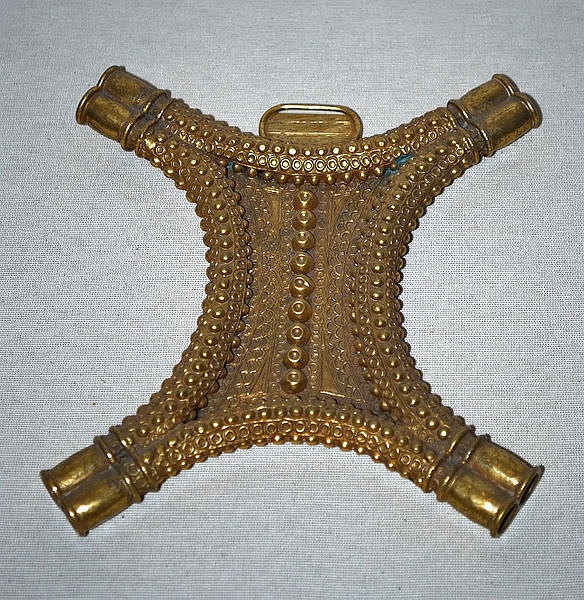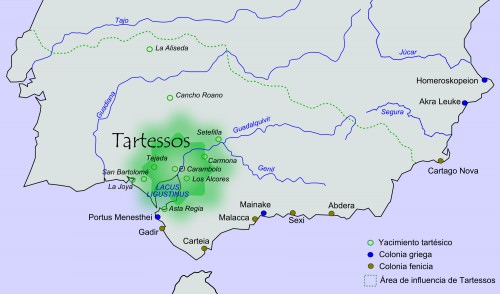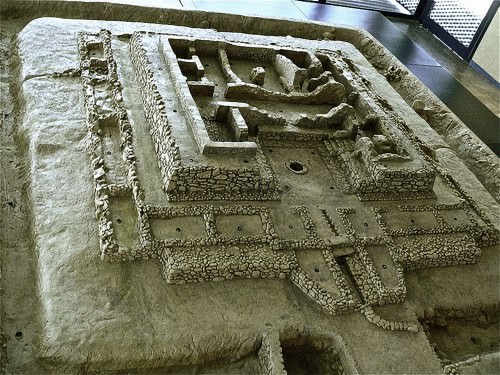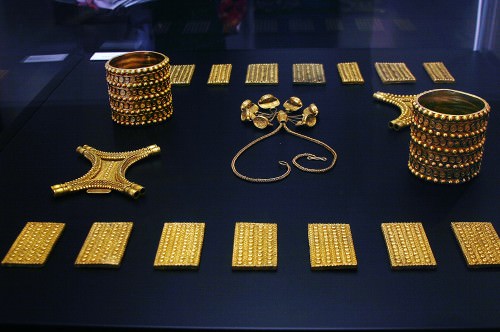Tartessos › Ancient History
Tartessos
Definition and Origins

The Tartessian culture existed from the 9th to the 6th centuries BCE in the south-westernmost part of Spain. The landscape between the modern cities Huelva and Cádiz is defined nowadays by the lower course of the Guadalquivir, but in antiquity this area was covered by a huge gulf that bordered the Mediterranean Sea. Tartessos extended around the coasts of this gulf and the neighboring lands to the north and east of it, both of which are part of the modern province of Andalucía.
If you have ever heard of " El Dorado ", you know that legends that center on riches, treasures, and adventurous voyages to distant and unknown lands last a long time. The Mediterranean people of the first millennium BCE knew about Tartessos, which, for them, was a legendary place, far away and full of innumerable treasures. Tartessos' wealth was described by ancient authors and mentioned multiple times in the Bible, yet the land remained as mythical (but far less well known) as "El Dorado" until archaeologists eventually found traces of the Tartessian culture in the second half of the 20th century CE.
Since the Tartessians themselves left us no written testimonies and the ancient writers sparsely mention this long bygone land, archaeological research is the key to understanding this unique culture, which was the first on the Iberian Peninsula to come in close contact with the old cultures from the east. The Phoenicians first recognized the potential of the hidden metal resources near the Tartessian gulf and consecutively explored and exploited them.
THE MEDITERRANEAN PEOPLE OF THE FIRST MILLENNIUM BCE KNEW ABOUT TARTESSOS, WHICH WAS, FOR THEM, A LEGENDARY PLACE, FULL OF INNUMERABLE TREASURES.
THE PHOENICIANS IN SPAIN
The oldest finds in connection with the Phoenicians in Spain were made in the area of the modern port of Huelva, the ancient city of Onoba. Here archaeologists discovered the remains of a rubbish pit of a Phoenician tradepost that was in use permanently in the second half of the 10th century BCE. Next to fine jewelry and adornments, there were consumable trade goods, such as wine and oil, as is indicated by the presence of thousands of shards from broken transport-amphoras.Ceramics like these, especially the Phoenician transport- amphora Torres 1.1.2.1, traveled far in Spain at a yet early stage of contact, but from the 8th BCE century they are to be found in ever increasing numbers in otherwise purely indigenous contexts as far north as the river Ebro.
Their content, wine, was the first oriental commodity to be selected by the native people around the Tartessian gulf in great amounts and went on to become the most famous Phoenician import in all of Spain (at least in the archaeological record).What the natives traded in return remains speculative, but it should not surprise if the Phoenicians, already in an early stage of contact, went for the metals and after the rights to mine and own them - especially since their trade post lay directly at the ancient estuary of the Guadalquivir River into the Tartessian gulf, the most comfortable connection to the ore-bearing mountains.
THE CREATION OF THE LEGEND OF TARTESSOS
At least from the late 9th century BCE onwards, an extended exploitation of the metal resources in the direct hinterland of Huelva, the Rio Tinto region, can be traced archaeologically. These opulent ore deposits were part of the so-called Iberian Pyrite Belt, a mountain range covering the northern part of the modern province of Andalucía. The Pyrite Belt carried copper, tin and lead in huge quantities, but also silver and gold in abundance and iron in lesser amounts.
The mining and other processes connected to the extraction and transportation of the unearthed metals were powered by the local elites and worked by their fellow men, but surely planned, supervised, and instructed by specialized Phoenician settlers.Since the seamen did not possess the capacities of manning these projects alone, they had to rely on indigenous forces. The native people surely already knew how to extract copper and how to alloy it to bronze, but the extraction and cupellation (dividing the noble metal from the minor elements connected to it) of silver and iron was new to them. Especially the cupellation of silver requires sophisticated knowledge and procedures. The work in those new industries began on a low scale, but the demand kept growing, especially for silver, and many mines were opened.
The extracted ores were cupellated and cast, mostly in nearby indigenous villages, as excavated castings molds and slags prove. Afterwards the processed metals were brought to centers of distribution (ultimately the Phoenician city of Gadir, modern Cádiz) and shipped overseas. The extent of the extracted metals can only be guessed, but the ancient sources attest incredible abundance. Strabo mentions that even the lead or stone anchors of leaving ships were replaced by silver ones (Geogr. 3,2,8), and Diodorus adds that the Phoenicians had to cut down all of Sierra Morena's forests to gather enough wood to heat the fires of the melting-ovens constantly (5, 35, 4-5).
The uncountable riches obtained in Tartessos' soils and mountains generated amazement in the Eastern Mediterranean communities which echoed through the centuries to come, indeed like an ancient version of the modern "El Dorado". The Bible states that Tartessos was the merchant of silver, iron, tin, and lead (Ez. 27, 12), and the only Tartessian king we know of was Argantino (Her. 1, 163), which translates into "The Silver One". Yet 90 years ago the archaeologist Adolf Schulten tried unsuccessfully to locate Argantinos city in search of the riches, which he suspected had to be there.
TARTESSIAN SETTLEMENTS
With the industries starting to flourish, the Phoenicians began to consecutively colonize the coasts of southern Spain, thus forming a net of autonomous cities in the 8th century BCE. No signs of resistance on the part of the indigenous people were found in any of the more than 150 places known in Iberia containing Phoenician material or structures. On the contrary, a Phoenician district was evolving in the native settlement of 8th century BCE Huelva.

Map of Tartessos with Phoenician and Greek colonies
The economic growth around Huelva and Cádiz led to a significant rise of population, and new settlements were found all around the Tartessian gulf. Nearly all of them served agricultural purposes, although seafood and breeding of cattle were also important sources for alimentation in Tartessos. Another frequent activity among these villages was the cutting and collecting of wood, as is proven especially for the area around Málaga. Here the population of the Portuguesian oak shrank from 15 % to 1.2 % during Tartessos' existence, underpinning Diodorus' claim.
The layout and the type of constructed living spaces varied from settlement to settlement. Sometimes building tradition followed bronze-age traditions, sometimes it was replaced by Phoenician techniques (though fitted to their own habits) and sometimes it was a mixture of both. In none of these villages there were found fortifications or other installations of martial character. Occasionally these little dwellings contain hints of Phoenician workshops, outposts of the bigger manufactories in the Phoenician colonies, but none of them is spared from the general influence the colonizers had had on the indigenous people for decades.

A model of the Tartessian site of Cancho Roano, Extremadura, Spain
The use of the pottery wheel, for example, soon became standardized and replaced the habit of modeling ceramics by hand completely during the 7th century BCE in most of Tartessos' villages and cities. From the 9th century BCE Tartessian artists aimed to imitate the oriental ware in their traditional way, thus creating unique and beautiful hybrid-ceramics. There are pieces modelled by hand imitating and interpreting the shape of Phoenician jugs with a painted decoration of solely traditional Iberian patterns, thus mirroring nicely Tartessos' roots. All the labors related to handcraft of any kind (also the above mentioned cupellation and casting of metals) were executed in the domestic spaces of the different houses that formed the new villages.
None of these Tartessian dwellings contained a building that could represent a specialized workshop producing on a larger scale, a public facility of any kind, or a residential edifice. All this indicates that the farmers were self-sustaining and relatively free from any kind of direct governmental or political control. The elites and high classes of Tartessian society gathered their status not so much from centralizing power over Tartessian people, but more from their elaborate bonds to the Phoenician merchantmen.
SOCIETY
While the Phoenicians profitably traded the Spanish metals in overseas regions, thus creating the long-living legend of Tartessos, the indigenous people partnering with them in the mining business benefitted by controlling the mines or by providing food, manpower, and wood. They gained possession of luxurious goods from the Far East, which were used not only to increase their own consumerist desires, but more importantly to create a whole new form of redistribution-based hierarchy in south-western Spain. In the late 9th century BCE the members of the different dynasties forming this hierarchy began to have themselves entombed representatively in impressive grave -mounds, of which a few could be excavated. Such tumuli originally housed one individual in the center but were filled with other burials over time. As is proven in multiple cases by the analysis of bones, the people buried alongside each other in a single tumulus belonged exclusively to one family.
Following Phoenician tradition, the cremated remains of the decayed were stored together with the grave goods in an urn. The usual grave goods consist in bronze vessels and jewelry made of bronze (fibulas and belt-buckles), both often showing Phoenician influence. These offerings vary from tomb to tomb, so that there cannot be created a typical ensemble for a Tartessian noblemen. There are, however, a handful of Tartessian tombs that stand out in precious and unique grave goods as well as in labor dedicated to the tombs' construction. In Huelvas necropolis La Joya we encounter an exceptional burial in a huge tumulus dating to the 7th century BCE, which covered a sole burial in an ample stone chamber. The deceased was accompanied (amongst other) by not only two most valuable iron knifes with handles made of ivory and a rare bronze thymaterion, but also by a complete two-wheeled chariot a la mode oriental, made completely out of bronze. This tomb illustrates to what extent the elites of Tartessian society profited from the contact to the Phoenicians and that they presented themselves to a great extent in oriental fashion.
ART OF TARTESSOS
While there are no fine pieces of art known (as neither are tombs) from their Bronze-Age ancestors, the people of Tartessos became pretty handy with different materials and produced wonderful objects in their very own technique. Their sophisticated craftsmanship is illuminated by a magnificent set containing 21 different adornments, including two bracelets, seven necklaces and 21 rectangular plaques made of gold. This set, weighing 2.39 kg all in all, was found buried in an urn in the Phoenician sanctuary of El Carambolo. The ensemble dates from the early 7th century BCE. The beautiful 24 carat golden pectorals from that hoard show a unique mix of oriental motives and Atlantic techniques and technologies. Especially the so called Lost-wax casting, which uses a model to duplicate the object in metal from, was famous on the British Isles then, and can be found executed in different pieces of the hoard. The hoard is believed to have belonged to a group of priests who used the objects in their ceremonies in the very sanctuary.

Treasure of Carambolo
DECLINE
Beginning in the early 6th century BCE, signs of decline are found all over Tartessos. The villages around the Tartessian gulf, some of them existing for barely 50 years, were given up one after another. The mines of the Rio Tinto region were closed, and related industries stopped flourishing and were left completely. Tartessian burials now show a mere martial atmosphere and fewer signs of Phoenician imports – instead Greek ceramics began to circulate more widely in south-western Spain.
Many of those developments are connected more or less to the leaving of the Phoenicians. After years of ongoing struggle, the Phoenicians lost their homeland to the Persians and began to subsequently abandon their colonies in Spain. Tartessian communities could not handle this waning of their economies' most important pillar, and their elites could not sustain their newly formed hierarchy anymore. All the structures defining Tartessian culture faded with the leaving of the Phoenicians and native people returned to a status quo, much resembling pre-Phoenician times.
See other Related Contents ››
LICENSE:
Article based on information obtained from these sources:with permission from the Website Ancient History Encyclopedia
Content is available under License Creative Commons: Attribution-NonCommercial-ShareAlike 3.0 Unported. CC-BY-NC-SA License